Are you a Quiet Speculation member?
If not, now is a perfect time to join up! Our powerful tools, breaking-news analysis, and exclusive Discord channel will make sure you stay up to date and ahead of the curve.
Modern is a format with plenty of decks, and many of those decks have multiple names. This problem becomes apparent as we move down the tier list, and rampant at the very bottom. There are many ways to name a deck, and this article explores some of the possibilities. It also introduces a three-level archetype system that can be used to easily classify decks.
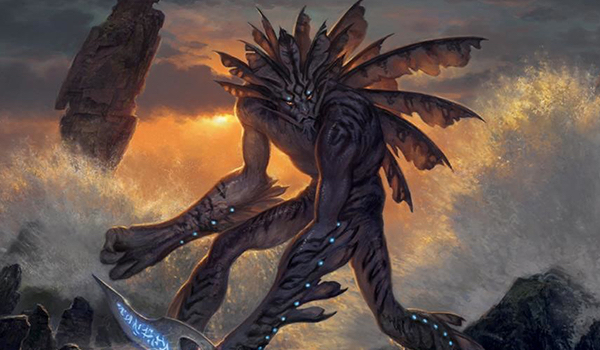
I know Jason has a piece planned on naming conventions, since it's something he deals with quite often at Modern Nexus during metagame updates. His views on the subject may differ from mine, of course. So don't take this article as the site's official position on deck names. My goal is to open up the conversation with some ideas and suggestions for classification moving forward.
Types of Deck Names
In the comments on my tournament report from last week, some readers noted concerns about "cute and unnecessary" deck names. I agree that deck names should be informative, but I don't think they necessarily must be informative in their own right. Unique names can be fine as long as a Google search of the name reveals more information about the deck, or that some subset of a format's playerbase is familiar with the name.
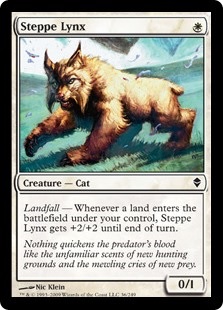 Jund, Affinity, and Ponza are examples of branded deck names. When players hear these names, they immediately associate them with the correct deck. Modern is a format in flux, with new strategies entering the format constantly (the latest spice: Hoogland's Naya Landfall deck from SCG Richmond). As such, it's impossible to have branded names for every deck. The player recognition for newer archetypes just isn't there. That said, Modern's top-tier archetypes all enjoy branded deck names. Most of the contention around names arises when we move to the format's lower tiers.
Jund, Affinity, and Ponza are examples of branded deck names. When players hear these names, they immediately associate them with the correct deck. Modern is a format in flux, with new strategies entering the format constantly (the latest spice: Hoogland's Naya Landfall deck from SCG Richmond). As such, it's impossible to have branded names for every deck. The player recognition for newer archetypes just isn't there. That said, Modern's top-tier archetypes all enjoy branded deck names. Most of the contention around names arises when we move to the format's lower tiers.
Formulaic deck names plug certain variables into a predictable formula, such as [color combination + key card] or [color combination + deck type]. Examples include Grixis Death's Shadow and Jeskai Control. These kinds of names immediately provide some details about a deck, but they can be vague enough to force curious players to click through to find out what the deck is actually doing.
In my perfect world, Modern deck names utilize both branded and formulaic names to make scrolling through datasets as intuitive and informative as possible. The rest of this section examines the pros and cons of each type of name.
[wp_ad_camp_1]
The Allure of Brands
Legacy and Vintage, formats that take their naming cues from the old Extended format, boast plenty of storied deck names: Gro-A-Tog, MUD, Oops All Spells, Tin Fins, Canadian Threshold, and Maverick, to name a few. Like formulaic deck names, these branded names have their pros and cons. One obvious pro is that brewers get to imbue on their creations a unique stamp of ownership that follows the deck as other players pick it up, tune it for shifting metagames, and evolve it over time.
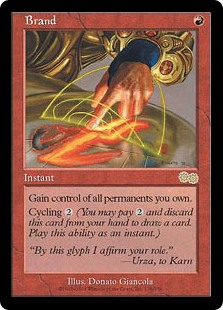 A more practical plus is that the development of specific decks can be tracked very efficiently online. A few minutes of googling a branded deck name reveals that deck's history, including outdated tech choices for the archetype that might prove useful in the future, or valuable strategic resources regarding its playstyle. Searching for a vague, formulaic name like "Sultai Midrange" is bound to cause more problems, since that name could apply to a huge range of decks spanning multiple formats.
A more practical plus is that the development of specific decks can be tracked very efficiently online. A few minutes of googling a branded deck name reveals that deck's history, including outdated tech choices for the archetype that might prove useful in the future, or valuable strategic resources regarding its playstyle. Searching for a vague, formulaic name like "Sultai Midrange" is bound to cause more problems, since that name could apply to a huge range of decks spanning multiple formats.
The biggest drawback to branded names is that, taken alone or even with a decklist, they may reveal little to nothing about the deck in question. Personally, I don't think this is much of a problem. The issue is greatly assuaged by the fact that branded names synergize with search engines to help players locate more information about a deck as needed.
A second potential complication is that multiple players may disagree on a deck's name. This isn't a point of contention for other eternal formats, so I don't see why it would be one in Modern. A large-scale transition to using branded names might aggravate some players, but all large-scale transitions temporarily alienate a segment of any population. I believe that the risk of irking a minority of the Modern playerbase outweighs the potential benefits of having standard, recognizable names for the format's decks.
Formulaic Fumbling
Over the past few years, coverage has attempted to standardize Modern deck names with formulaic deck names. While this approach is nice in theory, it fails on a few counts. For one, neither Wizards nor Star City Games has been very consistent. Sometimes, they'll name decks for key cards (Naya Company) or tribal synergies (UB Faeries) instead of for deck type. Other times, the formula provides a name too bland to be useful, forcing the use of a branded name (i.e. Soul Sisters instead of Mono-White Aggro).
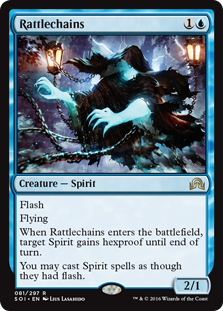 An issue with the shard/deck type strategy is it doesn't account for variations on a theme. UW Spirits and UW Merfolk, the deck names, are both archetypically UW Fish decks, but since the card core is so different, they require different names.
An issue with the shard/deck type strategy is it doesn't account for variations on a theme. UW Spirits and UW Merfolk, the deck names, are both archetypically UW Fish decks, but since the card core is so different, they require different names.
On the other side of the coin, sometimes conventional naming techniques leave us with too many names. GW Hatebears and Mono-White Death & Taxes are the same deck with minor differences in the creature suite; since these two decks operate in similar ways and share goals and card cores (Leonin Arbiter, Path to Exile, Aether Vial, Ghost Quarter), I think having two names is superfluous. I'd rather call them both Hatebears or Death & Taxes and assign color combinations at the beginning of their respective names to indicate whether they splash for Hierarch, Voice, and Scavenging Ooze.
The Level-Based Archetype Guide
Branded names won't fly for new or little-known Modern decks. For these, formulaic names work the best. To assign effective formulaic deck names, we need to clearly understand Modern archetypes.
This guide splits those archetypes into three levels, each signifying a deeper understanding of a deck's function---for example, aggro-control (a Level 1 signifier) is less specific than midrange (a Level 2), which is less specific still than rock (a Level 3). It follows that "Abzan Rock" is a more informative deck name than "Abzan Midrange" or even "Abzan," since it describes the deck's gameplan while allowing other decks in the same colors to be easily differentiated.
Level 1: Deck Type
Aggro, combo, control, aggro-combo, aggro-control, control-combo, aggro-combo-control
These seven deck types, made up of combinations of aggro, combo, and control, comprise Level 1, the most basic signifier.
Level 2: Playstyle
i.e. midrange
Level 2 signifiers describe how a deck plays. For example, midrange (a subtype of aggro-control) disrupts opponents somehow, then commits threats to the board to finish them off before they can recover.
Level 3: Gameplan
i.e. rock, stompy
Level 3 signifiers describe a deck's strategy in detail. To continue our midrange example from Level 2, the way midrange decks disrupt opponents and the kinds of threats they use depend on the deck's gameplan. Rock decks use spells and planeswalkers to disrupt opponents, especially favoring targeted discard and removal. Its threats are cheap and versatile. Stompy employs noncreature permanents for disruption, and expensive haymakers for threats.
This section looks at Modern's most well-known decks through the three-level lens. Large-text headers denote Level 1 signifiers, and bullet points denote Level 2 signifiers unless specifically marked by "L3" (in which case they denote Level 3 signifiers). In many cases, it's impractical to reduce the Level 2 signifiers further. Only aggro-control goes as deep as Level 3.
Aggro
Pure aggro decks win by turning creatures sideways. They rarely interact with opponents beyond just clearing the path for beaters.
 Zoo: Named for the real-life home of its creatures. Zoo is a Naya aggro deck, combining efficient threats with removal that often doubles as reach.
Zoo: Named for the real-life home of its creatures. Zoo is a Naya aggro deck, combining efficient threats with removal that often doubles as reach.
Modern examples: Naya Company, Gruul Zoo- Aura stompy: The word stompy has been used historically to describe two radically different deck types. The first use of the term dates to very early in the game, to describe an aggressive green deck featuring Rogue Elephant and pump spells: 9-Land Stompy. Later, the Extended deck, Señor Stompy, would rechristen the term to mean something completely different. This deck disrupted opponents with Winter Orb and Tangle Wire while beating them down with Trolls and Apes. Nowadays, both of these deck types are referred to as "stompy," to the understandable confusion of many. I will use the term stompy to refer to the permanent-based disruption deck, and aura stompy to describe the aggressive type. Aura stompy uses large quantities of efficient creatures like Zoo, but trades Zoo’s removal spells and reach for creature-enhancing enchantments or pump spells. In Modern, giving up creature interaction will get you killed, making these decks generally worse than Zoo.
Modern examples: Mono-Green Stompy
Combo
Combo decks try to assemble a combination of cards with powerful interactions as quickly as possible, and use that interaction to either win the game outright or leverage a major long-term advantage.
- Spell/permanent-based: Bread-and-butter combo decks that combine two spells or permanents, or a spell or permanent with a certain game state, to win.
Modern examples: Ad Nauseam, Grishoalbrand, Eggs - Land-based: Combo decks that win with their lands, these decks are harder to interact with, helping them dodge most conventional disruption (Path to Exile, Thoughtseize, Mana Leak). But they take longer to win than spell-based combo decks. Once the land-based decks assemble their combo, they use it to leverage a huge mana, card, or damage advantage.
Modern examples: Tron, Titan Breach
Control
Control is the slowest Level 1 archetype in Magic. It interacts with opponents as efficiently as possible to reach a gamestate from which opponents have almost no way to secure a victory, and then focuses on closing out the game.
 Weissman: Named after the creator of the original Weissman deck, The Deck. Weissman deploys large amounts of disruptive spells and eventually ends the game with a hard-to-interact-with threat. For The Deck, this win condition was the Bolt-proof Serra Angel and later the pseudo-hexproof Morphling. For Modern’s flexible Jeskai Nahiri, it can be Nahiri’s ultimate, the sorcery-resistant Celestial Colonnade, or a series of unblockable burn spells.
Weissman: Named after the creator of the original Weissman deck, The Deck. Weissman deploys large amounts of disruptive spells and eventually ends the game with a hard-to-interact-with threat. For The Deck, this win condition was the Bolt-proof Serra Angel and later the pseudo-hexproof Morphling. For Modern’s flexible Jeskai Nahiri, it can be Nahiri’s ultimate, the sorcery-resistant Celestial Colonnade, or a series of unblockable burn spells.
Modern examples: Jeskai Nahiri, UW Control, Esper Control- Prison: Named for its strategy of stopping opponents from doing anything. Prison decks lock opponents out of the game with noncreature permanents and win many turns later, generally with a card or combination of cards that is also useful in non-closing stages of the game (i.e. creature lands, planeswalkers, Codex Shredder). In Modern, the only lock pieces efficient enough to see mainboard play are Chalice of the Void, Blood Moon, and Ensnaring Bridge; as a result, there aren't that many Prison decks.
Modern examples: Lantern Control
Aggro-combo
Aggressive decks with game-winning interactions and important synergies fall under the aggro-combo umbrella. The combo element makes them faster or more resilient against a certain kind of strategy, but at the cost of weakening themselves to "hate," or specific targeted disruption.
- Pump: Pump decks throw a bunch of creature enhancement on a cheap threat with crucial text (hexproof, unblockable, "becomes a 9/9") and kills opponents with undercosted combat damage.
Modern examples: Death's Shadow Zoo, Infect, Bogles - Synergy: Synergy-based aggro-combo decks need one or two key cards to get going. Elves looks for mana dork into Elvish Archdruid or Heritage Druid to enable speedy Collected Companys; Affinity mulligans into hands toting "payoff cards" like Cranial Plating; Dredge needs openers with a way to start dumping cards into the graveyard. With those conditions met and uninterrupted, these decks are free to "go off" on their opponents, although they often win fairly (through combat damage).
Modern examples: Elves, Affinity, Dredge - Critical mass: Critical mass decks aim to draw the requisite number of a certain kind of spell. Burn wants six Lightning Bolts; Mill wants five Glimpse the Unthinkables. Of course, you can only run four of each, leaving critical mass decks to jam as many close analogs as possible and top things off with a minimal amount of interaction.
Modern examples: Burn, Mill
Aggro-control
Decks with a healthy mix of proactive and reactive elements that utilize tempo to win games before opponents can realize their own gameplans. Tempo and midrange, the two varieties of aggro-control decks, differ in the general sequence in which they apply disruption or pressure.
- Tempo: Tempo decks commit threats to the board, then disrupt opponents while attacking.
- (L3) Fish: Named for the tribe of the first fish tempo deck, Merfolk. Plays many interchangeable/synergistic threats that work together to further the clock or disrupt opponents, and a small number of noncreature spells.
Modern examples: Merfolk, Hatebears, Death & Taxes, Spirits 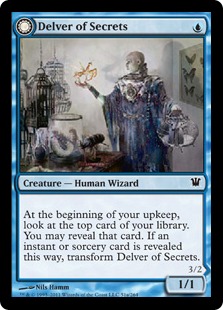 (L3) Grow: Named for the scaling nature of the archetype’s staple creatures. Plays a few highly efficient, individually powerful threats and disrupts opponents with noncreature spells. Often trades card advantage for speed. It should be noted that there are very few grow decks in Modern. Grixis Control, the most high-profile grow deck in the format, is actually more of a midrange deck with its focus on accruing value via Snapcaster Mage and Kolaghan's Command. Grow is probably under-explored in Modern because of its historical weakness to BGx midrange, which has dominated Modern for years. For the sake of example, the most celebrated grow deck in Magic is Legacy's Canadian Threshold.
(L3) Grow: Named for the scaling nature of the archetype’s staple creatures. Plays a few highly efficient, individually powerful threats and disrupts opponents with noncreature spells. Often trades card advantage for speed. It should be noted that there are very few grow decks in Modern. Grixis Control, the most high-profile grow deck in the format, is actually more of a midrange deck with its focus on accruing value via Snapcaster Mage and Kolaghan's Command. Grow is probably under-explored in Modern because of its historical weakness to BGx midrange, which has dominated Modern for years. For the sake of example, the most celebrated grow deck in Magic is Legacy's Canadian Threshold.
Modern examples: Monkey Grow, Counter-Cat
- (L3) Fish: Named for the tribe of the first fish tempo deck, Merfolk. Plays many interchangeable/synergistic threats that work together to further the clock or disrupt opponents, and a small number of noncreature spells.
- Midrange: Midrange decks disrupt opponents first, then cast creatures to pressure their life total.
- (L3) Rock: Named for the first Rock deck (developed by Sol Malka), whose primary threat—Phyrexian Plaguelord—bore an apparent resemblance to the WWE wrestler of the same name. Disrupts opponents with noncreature spells and planeswalkers and accrues card advantage with favorable trades, before taking games with efficient threats.
Modern examples: Jund, Abzan, Mardu Control - (L3) Stompy: As discussed above, named by the inventors of Señor Stompy (developed by Team AustiKnight). Disrupts opponents with noncreature permanents, then finishes the game with high-curve threats. Stompy decks sometimes play similarly to fish decks, except the disruptive effects are more powerful and not on bodies (i.e. Thorn of Amethyst over Thalia, Guardian of Thraben). Since that means fewer attackers, stompy’s threats have to pull double-duty when it comes to closing out games and they're frequently more expensive.
Modern examples: Skred Red, Colorless Eldrazi Stompy
- (L3) Rock: Named for the first Rock deck (developed by Sol Malka), whose primary threat—Phyrexian Plaguelord—bore an apparent resemblance to the WWE wrestler of the same name. Disrupts opponents with noncreature spells and planeswalkers and accrues card advantage with favorable trades, before taking games with efficient threats.
Combo-control
Combo-control interacts with opponents while setting up a combo finish. While combo-control decks banking on permanent-based disruption are theoretically possible (think Chalice, Moon, and Through the Breach), they don't exist in Modern.
- Spell-based: Interacts like a Weissman deck, but rarely plans to grind opponents out. Spell-based combo-control resolves its oops-I-win after having delayed its opponent's own win condition as much as it can, meaning it plays more to tempo than to attrition.
Modern examples: Scapeshift
Aggro-combo-control
These decks take on a tempo or midrange role in many games, but also house a game-winning combo. The combo often addresses weaknesses the deck has in  relation to the metagame (for example, Splinter Twin gave UR midrange an easy way to beat Tron).
relation to the metagame (for example, Splinter Twin gave UR midrange an easy way to beat Tron).
- Goodstuff: Decks full of quality Magic cards, often of the midrange variety. The combo card in these decks is generally weak on its own (i.e. Splinter Twin, Retreat to Coralhelm).
Modern examples: Knightfall - Synergy: Synergy-based aggro-combo-control decks play a host of creatures with strong abilities and include a few powerful interactions. Previously helmed by Birthing Pod, these decks now revolve around Chord of Calling and Collected Company.
Modern examples: Abzan Company, Kiki-Chord
Informing the Formula
With updated, clearly defined archetypes, the formula-based approach to deck naming becomes much more attractive. "Sultai Rock" is a fitting and descriptive name for Gerard Fabiano's "Sultai" from last year. "WR Prison" communicates a great deal more about the Chalice/Moon/Nahiri deck that made waves at an Open in May than "WR Control."
Of Modern's current branded names, only "Death's Shadow Zoo" bothers me. The deck just isn't a zoo deck. Its only reach spells are two Lightning Bolts, and it plays the full four Mutagenic Growth as well as 12 cantrips. It's clearly a pump-based aggro-combo deck. Death's Shadow is also a card I expect to creep into other decks as time goes by, all of them aggro decks of some variety, making "Death's Shadow Aggro" an equally unfitting name. Something like "Battle Rage Shadow," directly referencing the combo that makes the deck possible, or the more formulaic "Shadow Pump," would sit better with me.
Monkey's Last Word
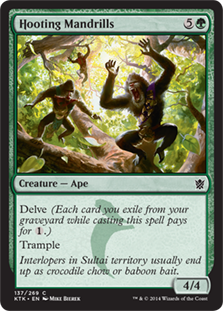 Before I end this article, I want to address the comments about Monkey Grow's name directly. Some users suggested "Temur Delver" or "Temur Midrange" as possible alternatives, but I think they're both too vague. Monkey Grow differs drastically from Todd Anderson's value-focused Temur Delver deck, or my own iGrow decks from the Grixis era. If we can agree that Monkey Grow is the only true grow deck of the three, though, I'm fine calling the deck "Temur Grow." Since grow decks are goodstuff decks, and we're unlikely to ever get strict upgrates to Delver, Tarmogoyf, and Lightning Bolt, we probably won't see many variations in the future.
Before I end this article, I want to address the comments about Monkey Grow's name directly. Some users suggested "Temur Delver" or "Temur Midrange" as possible alternatives, but I think they're both too vague. Monkey Grow differs drastically from Todd Anderson's value-focused Temur Delver deck, or my own iGrow decks from the Grixis era. If we can agree that Monkey Grow is the only true grow deck of the three, though, I'm fine calling the deck "Temur Grow." Since grow decks are goodstuff decks, and we're unlikely to ever get strict upgrates to Delver, Tarmogoyf, and Lightning Bolt, we probably won't see many variations in the future.
I'm excited to hear what the Nexus readership thinks about naming conventions in Modern. Let me know in the comments!





Seeing how similar Monkey Grow is to legacy’s “Canadian Threshold” I’d go with that.
Whenever someone asks me what I am playing the answer “Monkey Grow” tells them nothing (because Modern Nexus is the only place you will ever see the deck mentioned without specificly looking for it ^^) but when I say it`s like modern “Canadian Threshold” port they immediately know the decks gameplan and it’s general construction.
So while “Modern Canadian Threshold” might not have such a nice ring to it as “Monkey Grow” or “Temur Grow” it is more descriptive to everyone who isn’t familiar with the deck already.
This is exactly how I feel, and the principle concern that will inform our names going forward. I’ll take it a step further, and say that “Canadian Threshold” will lose far more readers than simply “Temur Delver,” or “Temur Tempo.”
Are you sure?
I´d think the name “Canadian Threshold” would atrackt more views if anything, not lose them since a lot of players that have been playing magic for a bit longer are familiar with the deck in legacy or have at least heared of the name and would be eager to check out it`s modern adaptation.
I might be missunderstanding your post though
I meant lose them as in they’d get lost reading it, but I can see how that was ambiguous.
I have to say, I’ve been playing for a long time (since Alpha) and the term “Canadian threshold” means for less to me (in fact nothing at all) than a deck subtitled “grow” which was actually a very recognisable and repeated deck naming term for years and years.
The “grow” moniker is fine, if applied to a predominantly blue-green tempo deck. I see it still being used a little, here and there. So it’s not a completely unknown quantity.
Also, Jordan, grow decks aren’t “goodstuff” decks. The original played mostly draw spells, cheap counters and a couple of efficient threats. The main engine was Gush. This isn’t the architecture of a goodstuff deck. It’s pure tempo.
Abzan and Jund are great examples of a “goodstuff” deck in modern, where the primary focus is topdeck card quality and affecting the board rather than card filtering, some light permission and synergy (which is what grow decks have all been about)
IMO, either names are actually bad. Look I not versed in legacy and have no idea what ‘Canadian Threshold’ is about (it’s not just an example, it’s really true), and until seeing the articles here at modern nexus to know wth was ‘monkey grow’.
I think that names should at last give a hint about the deck gameplay and composition. Color combination (the cloros itself or the ‘guild/shard’ names) should be placed at the deckname all times, and then a hint of about what the deck is about (Temur Tempo? Temur Delver? RUG Tempo?)
I think its silly to have to worry so much about deck names. And thats not a criticism of this article, but more over certain people who think deck names need to follow their own expectations, or they are stupid.
Monkey Grow is an interesting name, and it has a history that can be researched. Same goes for decks you mentioned, like Affinity, Jund, etc.. We dont call Affinity “Colorless Artifacts”, and no one has a shit fit when we interchange Bogles with Bant Hexproof. Let names be names. Worry more about the strength of a deck, not what its been labeled.
Good analysis either way. I personally like deck names that follow (colors) (playstyle) (gameplan)
I think you started out on the right track here differentiating storied names that are just an accepted thing (affinity, zoo, jund etc) vs functional names of colour plus style or card (jeskai control, grixis delver) but your 3 level thing seems pedantic and useless. Nobody is going to use the “aggro control” or “combo control” monikers so classifying that way is a waste of time.
Its also important to note that its not just for kicks – naming things properly makes it easier to cluster into archetypes which is huge for metagame updates and event analysis.
Id say theres a tension between deck names being organic and trying to make them logical or organized. I loved the name “knightfall” for the kotr coralhelm combo but I dont know that its won out yet – I still see “bant retreat” and “coralhelm combo” and just “bant company”.
Why are delver decks called delver decks and not tempo? Why dont we call rug delver “rug goyf”? Is “temur traverse” or “temur reveler” better than “temur tempo”. Ill say that specifically “monkey grow” just sounds stupid and is not something I want to ever say out loud. Counter cat? Sure. Eggs? Sure. Taking turns? Sure. “Goryobreachrakul”? No. I dont know why some pass and some dont and I know you guys are gonna be screwed if you try too hard to buck convention.
I will say ive played modern since format started and if someone told me they were playing tin fins or canadian threshold id have no idea what they were talking about. Probably best not to assume that legacy names would clear things up for modern players.
Honestly agree…most people were probably bitching because “Monkey Grow” is a terrible name that people dont wanna use on their pile of cards that cost them hundreds of dollars. There is no use arguing over how certain deck names “catch on”, as that isnt something we can quantify easily, though I would guess that baselines such as guild/clan names followed by archetype would more acceptable by a wider range of players. I honestly feel this conversation is a waste of time in the end. I applaud Jordan addressing what the readers were reacting to in the comments, but it will take way more than him writing an article to nail down naming conventions. Ultimately, people will do and say what they want, and I feel “Nexus” should provide their authors with the same freedom. Just be prepared to catch backlash when the names sound absurd jk
jk
Epiphany. Jordans delver should be called “hootie and the blowfish” cause the difference with reg temur delver is mandrils (hootie) and disrupting shoal which has a bunch of fish looking things on it (blowfish perhaps)
“On the other side of the coin, sometimes conventional naming techniques leave us with too many names. GW Hatebears and Mono-White Death & Taxes are the same deck with minor differences in the creature suite; since these two decks operate in similar ways and share goals and card cores (Leonin Arbiter, Path to Exile, Aether Vial, Ghost Quarter), I think having two names is superfluous. I’d rather call them both Hatebears or Death & Taxes and assign color combinations at the beginning of their respective names to indicate whether they splash for Hierarch, Voice, and Scavenging Ooze.”
None of the cards you’ve listed as core are core to Hatebears, though occasionally, along with the original Thalia, appear in Hatebear decks. The only core card shared by GW Hatebear decks and GW Death & Taxes is Noble Hierarch.
The misnaming issues with the two decks come from a period where D&T and Hatebears were both primarily GW, and shared Leonin Arbiter and Thalia…both cards that no other decks in the format played. The fundamental deck designs are different. D&T uses creatures with comes into play abilities in conjunction with Æther Vial to function as pseudo Instants and Sorceries along with creatures with static abilities as pseudo enchantments.
The fundamental change that needs to happen is websites, announcers, etc. need to stop mislabeling D&T. As a friend reminded me earlier, the difference is pretty easy to find. Look at the deck. Does Torpor Orb shut down all or part of the deck? If yes, it’s Death & Taxes. If no, it’s Hatebears.
How would you classify Bant Eldrazi? It seems like it’s almost a Fish deck, but almost a Stompy deck too.
Eldrazi is a very specific set of cards and strategies that see play in few places, if anywhere else.
The name Bant Eldrazi is perfectly fine. It gives a crystal clear image of the deck.
Agree. If a deck name can give you a very good idea of what’s in the deck, it’s already great. In terms of archetypes, though, I would classify Bant Eldrazi as an aggro-slanted midrange deck.